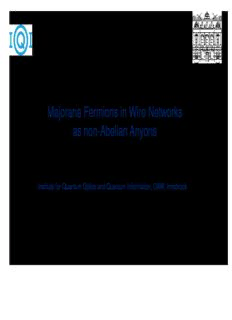
Majorana Fermions in Wire Networks as non-Abelian Anyons PDF
Preview Majorana Fermions in Wire Networks as non-Abelian Anyons
IQOQI AUSTRIAN ACADEMY OF SCIENCES Majorana Fermions in Wire Networks as non-Abelian Anyons M. Baranov Institute for Quantum Optics and Quantum Information, OAW, Innsbruck International School of Physics "Enrico Fermi" Quantum Matter at Ultralow Temperatures Varenna 7 – 15 July 2014 Outline: Exchange and statistics Majorana fermions as non-Abelian anyons “Making” Majorana fermions (Kitaev wire) Majorana fermions in atomic wires - “Making” Kitaev wire with cold atoms/molecules - Braiding protocol Demonstration of non-Abelian statistics Using Majorana fermions for QC - Deutsch-Jozsa algorithm Conclusion Innsbruck Majorana Team: Ying Hu Christina Kraus Catherine Laflamme Marcello Dalmonte Sebastian Diehl Andreas Läuchli Peter Zoller Exchange and statistics Particle exchange and statistics Behavior of the state (wave function) Statistics under the exchange of two identical (quasi)particles Exchange of two (quasi)particles 1 2 Ψ(r , r ,) → Ψ(r , r ,) = ? Ψ(r , r ,) 1 2 2 1 1 2 Properties of many-body wave functions: ψ(R , R ,; r , r ,) 1 2 1 2 R positions of quasiparticles i r positions of particles j r has to be single-valued with respect to particle coordinates j R but not necessarily with respect to quasiparticle coordinates i Exchange as adiabatic dynamical evolution General statements: 1. Adiabatic theorem: States in a (possibly degenerate) energy subspace separated from others by a gap remain in the subspace when the system is changed adiabatically without closing the gap. 2. Change under adiabatic transport (holonomy) = combination of Berry’s phase/matrix and transformation of instantaneous energy eigenstate (explicit holonomy) 3. Holonomy is invariant, but Berry’s phase/matrix and eigenstate transformation depend on choice of gauge (and can be shifted from one to the other) Exchange as adiabatic dynamical evolution For a unique ground state Ψ (single-valued) 2 1 separated by a gap from excited states 1 t ψ → eiϕψ , ϕ= − ∫ dt E(t) +α e m ti dynamical phase d 1 2 Berry phase α= i ∫ dt ψ| ψ =α (path) +ϑ g dt 1 2 α (path) geometrical phase g ϑ statistical angle - of interest! ψ → eiϑψ Exchange statistics Constraint on the exchange R relative position 12 σˆ 2 σˆ exchange double exchange R R 12,f 12,f 2 1 1 2 t e m ti 1 2 1 2 R R 12,i 12,i 0 R 0 R 12,i 12,i R R 12,f 12,f R = −R 12,f 12,i R = R 12,f 12,i σˆ 2 Is an identity? 3D case: σˆ 2 = 1 (identity!) C The contour C can be deformed 0 R to a point R = const (= R ) 12,i 12 12,i R (i.e., to the case when nothing happens) 12,f without crossing the origin R = 0 12 0 R 12,i Conclusion: in 3D only bosons (ϑ = 0 ) or fermions ( ϑ = π ) ψ → ± ψ
Description: